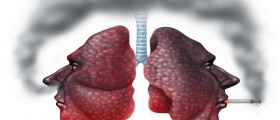
Tobacco smoking remains the single greatest cause of preventable death in the United States and worldwide. It is estimated that only in 2004, tobacco smoking caused 5.4 millions of deaths and more than 100 million deaths over the course of the 20th century. There are over 19 known chemical carcinogens in cigarette smoke, and a long-term exposure to compounds found in the smoke such as carbon monoxide, cyanide, and so forth, causes the loss of elasticity in the alveoli, leading to emphysema and chronic obstructive pulmonary disease. Carbon monoxide in tobacco smoke reduces the blood’s ability to carry oxygen and thus affects the functioning of every living cell in the body.
Carbon monoxide
Carbon monoxide is a highly toxic gas and very dangerous since it is colorless, odorless, tasteless and generally non-irritating. This gas occurs as a product of incomplete combustion of organic matter with insufficient oxygen supply to enable complete oxidation to carbon dioxide (CO2). Exposure greater than 100 ppm is considered especially dangerous to human health. Most of the people are in constant contact with carbon monoxide through cigarette smoke. Some other sources of exposure are more severe, including house fires, faulty furnaces, heaters, wood-burning stoves, internal combustion vehicle exhausts, electrical generators, and propane-fueled equipment. However, smokers are constantly exposed to carbon monoxide from the cigarettes, which cause both immediate and prolonged effects. Immediate effects of carbon monoxide exposure include shortness of the breath and rapid heartbeats. Prolonged negative effects include respiratory problems, coronary heart disease and formation of arterial build-up.
Long term effects of carbon monoxide exposure
Carbon monoxide binds to hemoglobin, which is the oxygen-carrying component in red blood cells. This way, the red blood cells lose their capacity to carry oxygen through the blood. Red blood cells are normally recycled after some period of time, but if carbon monoxide exposure becomes extensive, before the cells can be recycled, the condition called hypoxia occurs. This is a pathological condition in which the body is deprived of adequate oxygen supply. For this reason, most of the smokers are at an increased risk of developing different forms of arteriosclerosis. Carbon monoxide exposure is associated with a significantly shorter life span due to heart damage. However, different people are able to tolerate carbon monoxide differently. The tolerance level usually depends on various factors including activity level, rate of ventilation, overall health, cardiac output, anemia, metabolic rate and other hematological disorders. Short-time effects of carbon monoxide usually include shortness of the breath, headache, nausea, malaise and fatigue.









_f_280x120.jpg)







Your thoughts on this
Loading...